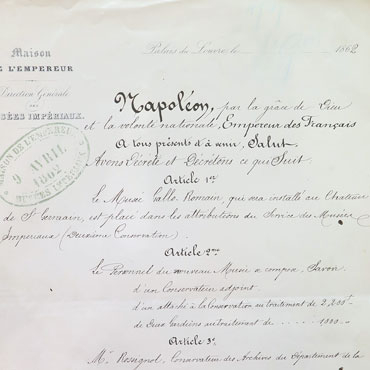
- Home
- The Commission de Topographie des Gaules
- The creation of the musée gallo-romain
“The museum of Gallic antiquities must be a scientific establishment where historians and archaeologists will be able to find and access with ease the most valuable and informative documents relating to our ancestors; where the French nation will be able to, in a fashion, look back on itself in its cradle.”
Adrien de Longpérier, 1863
Napoleon III’s personal project
Created by imperial decree on 8 March 1862, the musée gallo-romain, today the musée d'Archéologie nationale, was housed in the château at Saint-Germain-en-Laye, the seat of royal power under the ancien régime. In 1862, the emperor began a major restoration of the building and often visited unannounced to see how work was progressing. The restoration was entrusted to Eugène Millet, a pupil of Viollet-le-Duc.
The omnipresent Commission de Topographie des Gaules
In 1865, a commission was formed to consult on the organisation of the museum and determine its form. It was made up of figures from the world of science, most of whom were members of the CTG. They included Félicien de Saulcy, Edouard Lartet, Anatole de Barthélémy, Alfred Maury, Viollet-le-Duc and Casimir Creuly. Alexandre Bertrand, the CTG secretary, was named director of the museum shortly before its opening to the public in 1867.
A new kind of museum
From the beginning it was clear that this new museum was dramatically different to the existing art museums, such as the Louvre and the musée du Luxembourg. The museum not only displayed objects uncovered during excavations, it also explained these remains by drawing on the fields of botany, zoology, anthropology, epigraphy, numismatics and military science. It also gave access to documentary resources.
On 12 May 1867, as the universal exhibition marked the apogee of the Second Empire, Napoleon III himself inaugurated this museum whose creation he had followed with such interest. Underlining the museum’s value, he donated for its collections a signed copy of his Histoire de Jules César.
Partners and authors
Associated media
Open Media Library

View of the château of Saint-Germain during its restoration, 1862

View of the château of Saint-Germain, the restored keep, 1865

View of the courtyard of the château of Saint-Germain, 1862

The inauguration of the musée gallo-romain, as seen in the <em>Univers illustré</em>, 29 May 1867

